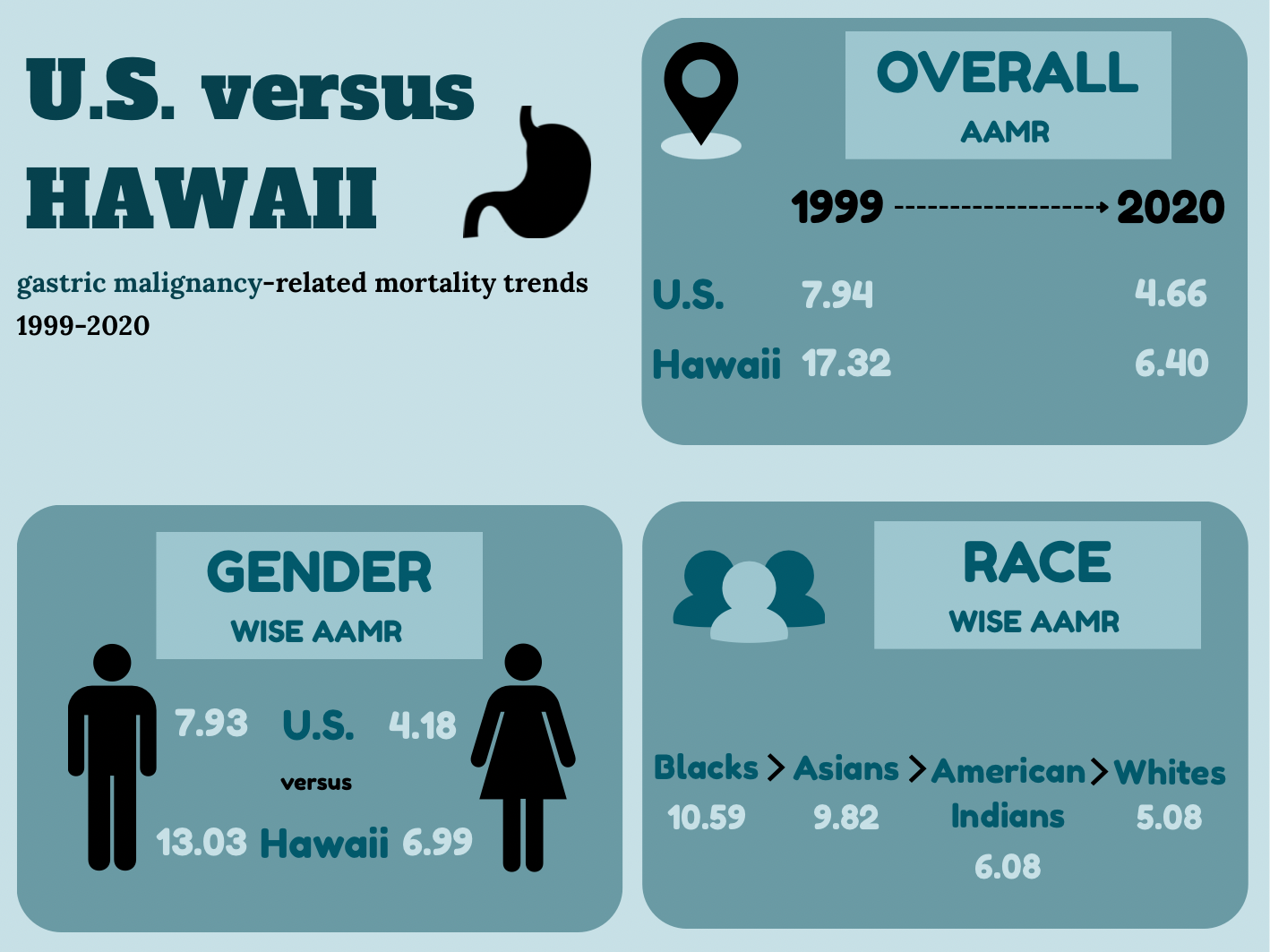Sunday Poster Session
Category: Stomach and Spleen
P2026 - Gastric Malignancy-Related Mortality Trends and Disparities: A Two-Decade Analysis in the United States versus Hawaii
Sunday, October 26, 2025
3:30 PM - 7:00 PM PDT
Location: Exhibit Hall

Yukthi Mudiam, MBBS (she/her/hers)
Apollo Institute of Medical Sciences and Research, Hyderabad, Telangana, India
Hyderabad, Telangana, India
Presenting Author(s)
Yukthi Mudiam, MBBS
Apollo Institute of Medical Sciences and Research, Hyderabad, Telangana, India, Hyderabad, Telangana, India
Introduction: Gastric malignancies contribute significantly to morbidity and mortality in the United States. However, specific trends in mortality outcomes have not been explored yet. This study aimed to evaluate trends and disparities in mortality due to gastric malignancy among adults in the United States and Hawaii from 1999 to 2020.
Methods: Records from the CDC WONDER (Centers for Disease Control and Prevention Wide-ranging Online Data for Epidemiologic Research) database were examined from 1999 to 2020 for gastric malignancy-related deaths (ICD-10 code C16) among adults ≥ 25 in the United States. Age-adjusted mortality rates (AAMRs) per 1 million individuals were calculated and stratified by year, sex, and race/ethnicity.
Results: A total of 276,023 gastric malignancy-related deaths occurred during the study period, with an overall AAMR of 5.82 (95% CI, 5.79-5.84). AAMR in the United States consistently declined from 7.94 (95% CI, 7.81-8.07) in 1999 to 4.66 (95% CI, 4.58-4.75) in 2020. Among all the states, the overall AAMR was the highest in Hawaii (9.65; 95% CI, 9.25-10.06). In 2019, Hawaii experienced an AAMR of 17.32 (95% CI, 14.40-20.24), which increased to 18.05 (95% CI, 15.11-20.99) in 2000. This was followed by a sharp decline to 13.77 (95% CI, 11.24-16.30) in 2001. Between 2001 and 2018, the AAMR in Hawaii drastically reduced to 5.09 (95% CI, 3.91-6.51). However, it increased to 6.40 (95% CI, 5.06-7.99) by the end of the study period. In the United States, men exhibited a higher AAMR (7.93; 95% CI, 7.89-7.97) than women (4.18; 95% CI, 4.15-4.20). Likewise, men were more affected (13.03; 95% CI, 12.32-13.73) than women (6.99; 95% CI, 6.52-7.45) in Hawaii. Race-wise analysis showed that the Blacks or African Americans experienced the highest AAMR of 10.59 (95% CI, 10.50-10.69), followed by Asians or Pacific Islanders (9.82), American Indians or Alaska Natives (6.08), and the Whites (5.08).
Discussion: Although gastric malignancy-related mortality rates showed a stable decline throughout the study period in the United States, the death rates in Hawaii slightly increased from 2018 to 2020. Men and Blacks or African Americans were disproportionately affected. It is essential to outline effective management protocols to address these demographic disparities.

Figure: Gastric malignancy-related mortality trends in the United States versus Hawaii: Age-adjusted mortality rates (AAMR) per 100,000 individuals (stratified by year, sex, race/ethnicity)
Disclosures:
Yukthi Mudiam indicated no relevant financial relationships.
Yukthi Mudiam, MBBS. P2026 - Gastric Malignancy-Related Mortality Trends and Disparities: A Two-Decade Analysis in the United States versus Hawaii, ACG 2025 Annual Scientific Meeting Abstracts. Phoenix, AZ: American College of Gastroenterology.
Apollo Institute of Medical Sciences and Research, Hyderabad, Telangana, India, Hyderabad, Telangana, India
Introduction: Gastric malignancies contribute significantly to morbidity and mortality in the United States. However, specific trends in mortality outcomes have not been explored yet. This study aimed to evaluate trends and disparities in mortality due to gastric malignancy among adults in the United States and Hawaii from 1999 to 2020.
Methods: Records from the CDC WONDER (Centers for Disease Control and Prevention Wide-ranging Online Data for Epidemiologic Research) database were examined from 1999 to 2020 for gastric malignancy-related deaths (ICD-10 code C16) among adults ≥ 25 in the United States. Age-adjusted mortality rates (AAMRs) per 1 million individuals were calculated and stratified by year, sex, and race/ethnicity.
Results: A total of 276,023 gastric malignancy-related deaths occurred during the study period, with an overall AAMR of 5.82 (95% CI, 5.79-5.84). AAMR in the United States consistently declined from 7.94 (95% CI, 7.81-8.07) in 1999 to 4.66 (95% CI, 4.58-4.75) in 2020. Among all the states, the overall AAMR was the highest in Hawaii (9.65; 95% CI, 9.25-10.06). In 2019, Hawaii experienced an AAMR of 17.32 (95% CI, 14.40-20.24), which increased to 18.05 (95% CI, 15.11-20.99) in 2000. This was followed by a sharp decline to 13.77 (95% CI, 11.24-16.30) in 2001. Between 2001 and 2018, the AAMR in Hawaii drastically reduced to 5.09 (95% CI, 3.91-6.51). However, it increased to 6.40 (95% CI, 5.06-7.99) by the end of the study period. In the United States, men exhibited a higher AAMR (7.93; 95% CI, 7.89-7.97) than women (4.18; 95% CI, 4.15-4.20). Likewise, men were more affected (13.03; 95% CI, 12.32-13.73) than women (6.99; 95% CI, 6.52-7.45) in Hawaii. Race-wise analysis showed that the Blacks or African Americans experienced the highest AAMR of 10.59 (95% CI, 10.50-10.69), followed by Asians or Pacific Islanders (9.82), American Indians or Alaska Natives (6.08), and the Whites (5.08).
Discussion: Although gastric malignancy-related mortality rates showed a stable decline throughout the study period in the United States, the death rates in Hawaii slightly increased from 2018 to 2020. Men and Blacks or African Americans were disproportionately affected. It is essential to outline effective management protocols to address these demographic disparities.

Figure: Gastric malignancy-related mortality trends in the United States versus Hawaii: Age-adjusted mortality rates (AAMR) per 100,000 individuals (stratified by year, sex, race/ethnicity)
Disclosures:
Yukthi Mudiam indicated no relevant financial relationships.
Yukthi Mudiam, MBBS. P2026 - Gastric Malignancy-Related Mortality Trends and Disparities: A Two-Decade Analysis in the United States versus Hawaii, ACG 2025 Annual Scientific Meeting Abstracts. Phoenix, AZ: American College of Gastroenterology.

